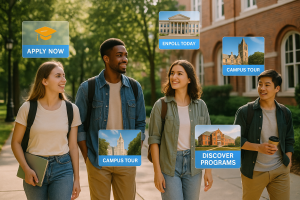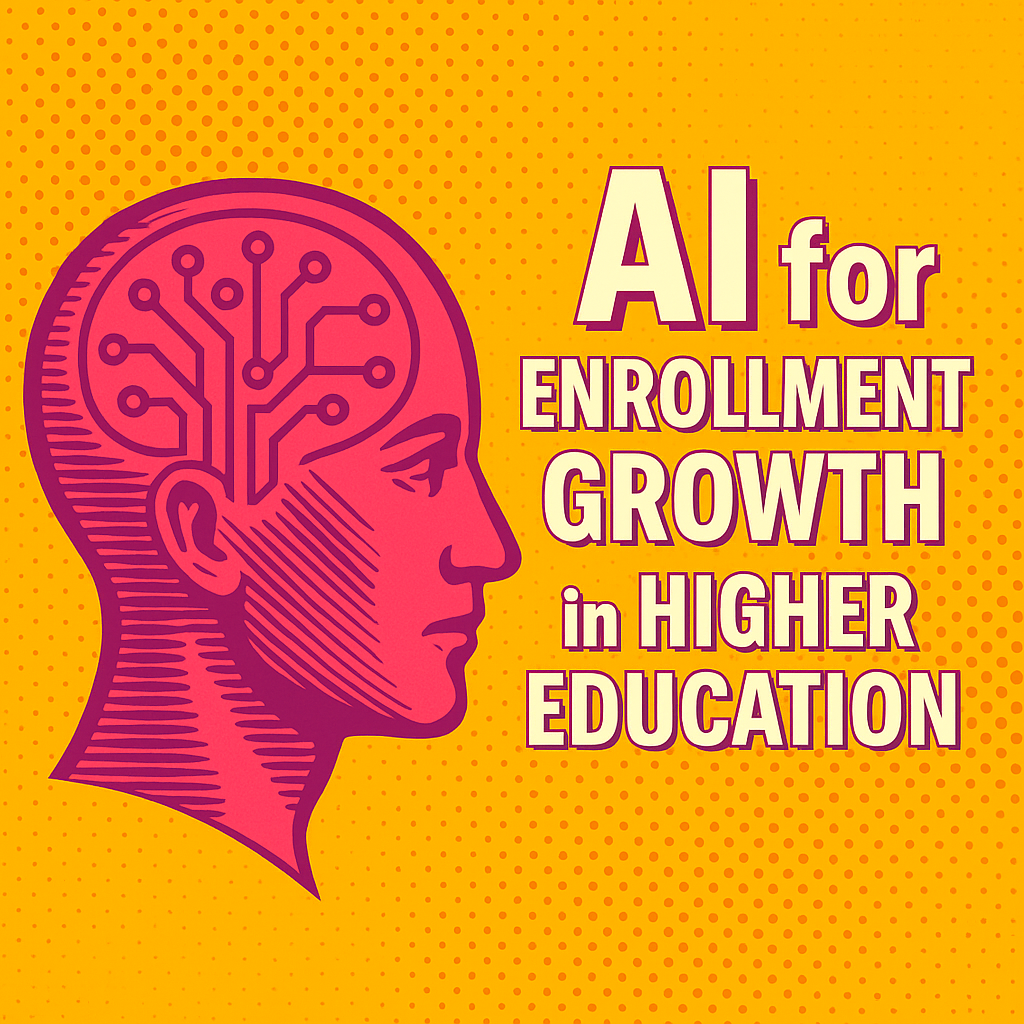The digital transformation sweeping across industries has reshaped the way higher education institutions engage with prospective students. As competition intensifies and traditional recruitment strategies lose their edge, colleges and universities are turning to artificial intelligence (AI) and machine learning (ML) to gain a performance-driven advantage. These technologies offer more than just automation—they unlock predictive power, real-time responsiveness, and hyper-personalization at scale.
This guide explores how AI and ML can revolutionize higher education enrollment marketing, helping institutions increase applications, optimize ROI, and build sustainable student pipelines.
Why AI and Machine Learning Are Essential for Higher Ed Marketing
1. The Growing Complexity of Student Journeys
Prospective students no longer follow a straight line from awareness to enrollment. They may browse a university website, follow on TikTok, attend a virtual open house, and download a program guide—over weeks or even months.
AI enables marketers to map and anticipate these complex, non-linear journeys. Behavioral data from websites, social platforms, and CRMs can be analyzed to predict where students are in their decision-making process—and guide them toward the next step.
🧭 AI in action: Predictive pathing algorithms can suggest when a student might be ready for a campus visit, triggering a personalized email invitation at the optimal time.
2. Rising Demand for Personalization
Gen Z expects more than one-size-fits-all communication. They want content that resonates with their interests, goals, and identity.
AI makes it possible to deliver personalized messages, landing pages, and ads based on student behavior, demographics, and intent. Institutions can move from general messaging to “Netflix-style” experiences that reflect what each student values most.
3. The Need for Real-Time Optimization
AI removes the guesswork and lag time from campaign performance adjustments. Platforms like Google Performance Max and Meta’s Advantage+ use AI to shift budgets, rotate creative, and retarget high-intent users in real time.
This means marketing teams can respond to trends instantly—whether it’s a drop in yield for a program or a sudden surge in inquiries after a news mention.
4. Taming the Data Overload
Higher education marketers deal with vast amounts of data from CRM systems, digital ad platforms, website analytics, and social channels.
AI excels at processing this data and extracting actionable insights. Instead of drowning in reports, enrollment teams get prioritized leads, churn risk alerts, and predictive trend forecasts—faster and more accurately than manual analysis.
Core Applications of AI and ML in Higher Education Marketing
1. Predictive Analytics for Enrollment Forecasting
Predictive analytics is one of the most transformative applications of AI in higher education marketing. By evaluating thousands of historical and real-time data points—including inquiry source, demographic information, browsing behavior, academic interest, and even engagement on specific content—AI models can forecast a prospective student’s likelihood to convert. Institutions can identify patterns in yield by region, income level, GPA, or program preference, allowing them to forecast class sizes more accurately and allocate recruitment resources strategically.
Example: A university used predictive analytics to determine that students interacting with its business program pages and opening emails within 24 hours had a 70%+ chance of applying. These students were then assigned to counselors for immediate outreach, leading to improved conversion rates and more efficient use of staff time.
2. AI-Powered Audience Segmentation

AI takes audience segmentation beyond basic demographic grouping, enabling institutions to create highly granular micro-segments based on student behavior, search history, academic profiles, device usage, and even social engagement. These rich segments help universities tailor messaging that resonates on an individual level, boosting relevance and response rates. For example, students interested in health sciences can receive different email sequences and ad campaigns than those pursuing the arts or technology.
Tip: Tools like Adobe Audience Manager and Meta’s Lookalike Audiences use AI to identify behavioral traits of your best applicants and find similar audiences across digital platforms. This means your campaigns are continually refined to target those most likely to engage, apply, and enroll.
3. Automated Media Buying and Budget Optimization
Manual media buying is time-consuming and often reactive. AI-driven platforms change the game by automating ad placements and dynamically optimizing budgets in real time. These algorithms analyze channel performance, lead quality, click-through rates, and conversion behavior to adjust spend for maximum ROI. Marketing teams no longer have to guess which platform or creative will perform best—AI systems continuously test and optimize to ensure top-performing combinations get the most investment.
Tools to try: Platforms like Google Performance Max, The Trade Desk, and other programmatic demand-side platforms (DSPs) offer AI-powered bidding strategies that adapt to changing campaign conditions. These tools help universities reduce cost per lead (CPL), increase application volume, and maximize campaign efficiency without manual intervention.
4. Conversational AI and Chatbots
AI-powered chatbots are becoming essential for modern enrollment marketing strategies. These bots can handle inquiries 24/7, answer frequently asked questions, schedule campus tours, and guide students through critical steps like starting or finishing an application. Advanced bots integrate with CRM systems to personalize interactions based on a student’s profile, interest area, or stage in the decision journey.
Bonus: Many platforms now support multilingual AI chatbots, making it easier to engage international students in their native languages. This added layer of personalization not only enhances user experience but also increases the likelihood of inquiry-to-application conversion among diverse student populations.
5. Dynamic Creative Optimization (DCO)
Dynamic Creative Optimization (DCO) uses machine learning to test multiple ad creatives—images, headlines, CTAs—and serve the best-performing combinations to each user based on real-time engagement data. This ensures that prospective students see the content most relevant to their interests, behavior, and demographic profile, improving both click-through and conversion rates.
Example: A prospective nursing student in Florida might see a Facebook ad showcasing the university’s simulation lab and featuring a testimonial from a nursing alum. In contrast, a student interested in entrepreneurship from Illinois might see ads highlighting faculty expertise and business incubator success stories. With DCO, these highly tailored experiences happen automatically and at scale.
6. Sentiment Analysis and Social Listening
AI-powered sentiment analysis enables higher education marketers to understand how their brand is perceived across social media platforms, forums, and review sites. These tools analyze language patterns to detect positive, neutral, or negative sentiment around campus events, academic programs, or marketing campaigns. Social listening also helps identify emerging topics or student concerns that can be addressed proactively.
Leveraging tools like Hootsuite Insights or Brandwatch allows universities to track reputation in real time and adapt messaging to match the tone and mood of their target audiences. Whether it’s capitalizing on a trending topic or mitigating reputational risks, AI helps institutions stay one step ahead in their communications.
Real-World Campaign Success: AI for STEM Enrollment
Challenge: A mid-sized public university faced declining enrollment in STEM programs.
Solution:
- Used predictive analytics to identify STEM-interested prospects
- Deployed AI chatbots to answer program-specific questions
- Shifted ad budgets dynamically based on real-time engagement signals
Results:
- ✅ 35% increase in qualified STEM applications
- ✅ 27% drop in cost per application (CPA)
- ✅ Higher tour bookings and application completion rates
Integrating AI with Higher Ed Marketing Systems
| System | AI Benefit |
|---|---|
| CRM (Slate, TargetX, Element451) | Predictive lead scoring, automated follow-ups |
| Google Ads / Meta | Smart bidding, audience expansion, creative rotation |
| Email Marketing | AI-optimized subject lines, send times, content |
| Web Analytics | Journey prediction, attribution modeling, heatmaps |
📈 Pro Tip: Connect all systems through APIs or CDPs (Customer Data Platforms) to give AI tools the data they need for maximum performance.
Best Practices for Implementing AI in Enrollment Marketing

- Start with Clear Goals
Define success metrics like cost per lead (CPL), application conversion rate, and enrollment yield. - Invest in Clean Data
AI is only as good as the data you feed it. Sync and cleanse your CRM regularly. - Pilot Before You Scale
Test AI tools in small campaigns—like a chatbot on the STEM program page—before rolling out across departments. - Balance AI With Human Strategy
AI suggests. Humans decide. Use insights from AI to empower creative and strategic decisions—not replace them.
Common Barriers to Adoption (And How to Overcome Them)
- Staff Resistance: Offer training and explain how AI supports—not replaces—their work.
- Budget Concerns: Start with cost-efficient tools like Meta Advantage+ or Google’s Smart Campaigns.
- Privacy Risks: Choose vendors that comply with FERPA, GDPR, and other student data regulations.
- Lack of Internal Expertise: Partner with agencies experienced in AI-driven higher ed campaigns.
AI Tools Worth Exploring
| Tool | Use Case |
|---|---|
| Salesforce Einstein | AI insights for recruitment and admissions |
| Drift / Intercom | Conversational AI for inquiry handling |
| Adobe Sensei | Creative personalization and audience segmentation |
| Hootsuite Insights | AI-powered social sentiment monitoring |
| Google Performance Max | Multi-channel smart bidding and creative optimization |
Future Trends: What’s Next for AI in Enrollment Marketing
- Hyper-Personalized Video Outreach
Tools like Synthesia allow universities to send AI-generated videos with names, majors, and personalized messages. - Voice Search and Smart Assistants
Optimizing content for “Hey Siri” or “Alexa” queries like “Best computer science programs near me.” - Advanced Yield Forecasting
Dynamic models predict how many students will enroll and where interventions are needed. - AI-Powered Virtual Tours
Platforms like YouVisit can tailor tour content dynamically—engineering students see labs, while artists see galleries.
Measuring Success: AI’s Impact on Enrollment Marketing
| Metric | Description |
|---|---|
| CPL | Lowered via more efficient targeting and media buying |
| Conversion Rate | Improved through better segmentation and messaging |
| Yield Rate | Increased by aligning counselor time with AI-identified top leads |
| Application Completion Rate | Boosted by chatbot nudges and automated reminders |
📊 Dashboards: Use platforms like Tableau or HubSpot to visualize these KPIs weekly or monthly.
Conclusion: AI Is No Longer Optional
Relying on outdated marketing tactics puts your enrollment goals at risk. AI and machine learning offer a smarter, more efficient, and student-focused approach to recruitment. Whether you want to boost yield, reach underrepresented students, or maximize your ad budget, AI is the game-changer.
Ready to Elevate Your Enrollment Marketing with AI?
Partner with Propellant Media to implement AI-powered strategies that drive measurable growth. Our team specializes in helping higher ed institutions attract, convert, and enroll the right students—smarter and faster
➡️ Contact us today to schedule your AI marketing consultation.

